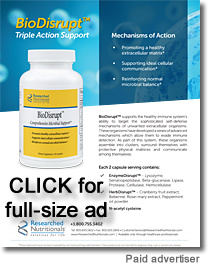|
Page 1, 2
The definition of erectile dysfunction (ED) is the inability to obtain or maintain an erection firm enough for sexual intercourse. Historically, admitting to having ED was considered taboo and downright embarrassing until the advent of sildenafil citrate (Viagra) in 1998. Sildenafil liberated men from the stigma of having ED, and it opened a conversation about a problem that has existed for centuries. Up to 10% of men younger than forty suffer from ED and upwards of 60% by age 69.1
 Townsend Letter provides a platform for those examining and reporting on functional and integrative medicine. Please support these independent voices. Townsend Letter provides a platform for those examining and reporting on functional and integrative medicine. Please support these independent voices. |
The Physiology of an Erection
To learn how to treat erectile dysfunction, it is useful to understand how normal pelvic functioning works. Penile engorgement (tumescence) is a neurovascular event influenced by psychological and hormonal factors.
During sexual stimulation, sexual thoughts, or nocturnal erections, the neurotransmitter nitric oxide (NO) is released from the endothelial cells and the parasympathetic nerve terminal causing relaxation of two cylinder-like muscles called the corpora carvenosum. Nitric oxide influences an increase in concentrations of cyclic guanosine monophosphate (cGMP), which after numerous pathways triggers smooth muscle relaxation, and simultaneous closing of small veins traps blood in the cavernosal muscles, keeping blood in the cavernosal tissues that cause and maintain an erection.
Detumescence or a flaccid penis after ejaculation occurs from two events: a sympathetic effect during ejaculation inducing a breakdown of cGMP by the enzyme phosphodiesterase-5 and opening of the venous channels, thereby, expelling blood out of the carvenosum muscles, restoring flaccidity.2
The bottom line is that for penile erections to occur, there needs to be smooth and unobstructed transmission of nerve impulses and blood through the penile vessels
 What Are the Major Causes of ED? What Are the Major Causes of ED?
ED is caused by vascular, hormonal, neurogenic, pharmacological, or psycho-genic factors. Performance anxiety where the person fears failing in a sexual scenario is a common psychogenic cause for ED.3 Neurogenic causes are related to diseases like Alzheimer's, Parkinson's, stroke or spinal cord injuries. Radical removal of the prostate (also called prostatectomy) is the cause of nerve-related ED as nerve injury is possible despite advances in surgical methods.4
Testosterone (T) has an indirect influence on penile function. While the connection between T and erectile dysfunction is not linear, the master androgen is still significantly involved in penile function in adults. T supports the integrity of the corpus carvenosum and the vasculature that feeds the penis.
Nitric oxide (NO) is the key mediator for erectile function. NO is synthesized by the enzyme NO synthase (NOS), which is produced by endothelial cells (eNOS) and non-adrenergic/non-cholinergic (NANC) nerves (nNOS). Both eNOS and nNOS have been shown to be up-regulated by T.5
Lastly, T regulates the enzyme PDE5, which underlies the molecular mechanism that leads to the conclusion of an erection.6
Drug-Induced Erectile Dysfunction
Antidepressants, including selective serotonin reuptake inhibitors drugs and antihypertensives, are among the most common drug classes involved in the development of erectile dysfunction.7
Thiazides, followed by β blockers, are the most common groups of antihypertensive drugs that cause erectile dysfunction, whereas α blockers, angiotensin-converting enzyme inhibitors, and angiotensin receptor blockers are the least likely of these drugs to cause erectile dysfunction.8
Opioids are used for chronic pain or for recreational use, and there is currently an epidemic of opioid addiction in the United States. Opioids induce ED by inhibiting gonado-tropin-releasing hormone (GnRH), which leads to a decrease in the production of luteinizing hormone (LH). Decreased levels of LH, in turn, inhibit production of testosterone, which – in both men and women – can cause depression and sexual dysfunction.9
Pharmaceutical Treatment for ED
The first line medical treatment for ED is phosphodiesterase inhibitors-5 (PDE-5) like sildenafil (Viagra; USA), tadanafil (Cialis; USA), verdenafil (Levitra; USA), udenafil (Zydena; South Korea), and mirodenafil (Mvix; South Korea).
These drugs facilitate erection by inhibiting the PDE5 enzyme, by blocking the degradation of cyclic guanosine monophosphate (cGMP) in the cavernous smooth muscles. This inhibition results in the prolonged activity of cGMP, which further decreases intracellular calcium concentrations, maintains smooth muscle relaxation and, hence, results in rigid penile erections.
Numerous placebo-controlled studies have shown that the number of erections and rates of penile rigidity, orgasmic function, and overall satisfaction improved with sildenafil more than placebo.
The most common adverse events associated with all of the PDE-5 inhibitors10 are headaches in 16% of men; flushing in 10% of men; dyspepsia (7%); nasal congestion (4%), and visual disturbances/color sensitivity in about 3%. Tadalafil distinguishes itself from vardenafil and sildenafil by the relative lack of visual side effects. It does, however, have an additional possible adverse effect, which is back pain and/or myalgia.11
A clinical observation by the author is penile desensitization, where a numbing-like effect on the organ occurs. Patients would often say, "I feel like my penis is detached from my body" or "I am getting an erection, but I am not enjoying it."
Also, delayed ejaculation is another complaint clinically observed in men using PDE-5 inhibitors where the man is unable to reach orgasm. This is a frustrating scenario for men that can lead to less sexual desire.
Metabolic Syndrome
Persons with metabolic syndrome can be identified by a distinct pattern of abdominal obesity (waist circumference >40 inches in men), atherogenic dyslipidemia (triglycerides ≥150 mg per 100 ml, HDL <40 mg per 100 ml, small LDL particles and normal or slightly elevated LDL), hypertension (≥130/85 mm Hg), insulin resistance (fasting blood glucose ≥10 0 mg per 100 ml), and elevated levels of prothrombotic and proinflammatory markers. Metabolic syndrome and insulin resistance are closely linked to ED. In one recently conducted study of 120 men with ED and no evidence of diabetes, 40% of patients fulfilled strict criteria for metabolic syndrome, and 73% were insulin resistant.12
Strong Cardiovascular-Penile Connection
There is a significant correlation between ED and cardiovascular disease (CDV).
In a meta-analysis of 12 prospective cohort studies, strong evidence showed that erectile dysfunction is indeed significantly and independently associated with an increased risk of not only CVD but also coronary heart disease, stroke, and all-cause mortality.13
Diagnosis
The main goals of assessment of erectile dysfunction are the following:
1. Establish whether the patient truly has erectile dysfunction;
2. Identify the cause of the disorder;
3. Evaluate risk factors and potentially life-threatening comorbid disorders associated with erectile dysfunction.
The diagnosis of erectile dysfunction requires a comprehensive sexual and medical history that include a validated questionnaire, the Sexual Health Inventory for Men (SHIM), and asking if they experience a rigid erection at night, in the morning, or during masturbatory approaches. The presence of rigid morning or night erections, or rigid erections at any sexual thought suggests a mainly psychogenic cause. Conversely, erectile dysfunction with a gradual onset, progressive course, or long duration suggests a predominantly organic cause.
Laboratory testing should include the following:
- Fasting blood glucose
- Hemoglobin A1c
- Total and Free Testosterone
- Luteinizing hormone (LH)
- DHEA -S
- Prolactin
- Lipid profile
- C-Reactive Protein
- Endothelin-1
Natural Treatment
The role of the practitioner providing a naturopathic treatment plan is to first identify the cause of the individual's ED. If the cause is psychogenic (i.e. performance anxiety, depression, relationship problems), referral to a psychotherapist should be considered. Organic causes like metabolic syndrome, insulin resistance, or diabetes type II can be properly treated with lifestyle medicine and other numerous nutritional prescriptions beyond the scope of this article to discuss.
Hormonal causes should be treated with natural, lifestyle methods to help increase testosterone levels before prescribing supplemental, exogenous testosterone therapy. If DHEA-S levels are low, supplement with 50 mg of DHEA.
Lifestyle Measures
A sedentary lifestyle, smoking, alcohol or drug misuse, sleep disorders, obesity, and metabolic syndromes have all been associated with erectile dysfunction.14
Intensive lifestyle changes that include a Mediterranean type diet, circuit-type resistance training, with 15- to 60-second rest between sessions has shown to improve erectile score in a randomized trial. Men in the intervention group had a significant decrease in glucose, insulin, low-density lipoprotein cholesterol, triglycerides, and blood pressure, and a substantial increase in HDL cholesterol.15
Page 1, 2
|
![]()
![]()
![]()
![]()






